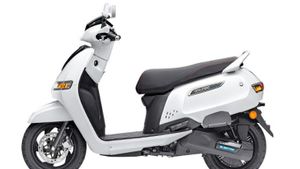JAKARTA - A SpaceX rocket launched into space again on the morning of Friday December 16 to carry a US-France satellite designed to conduct an unprecedented global survey of Earth's surface waters. This is a mission that is expected to explain the mechanisms and consequences of climate change.
A Falcon 9 rocket owned and operated by commercial rocket company Elon Musk lights up the early morning skies along the California coast as it lifts off its launch pad at Vandenberg US Space Force Base, about 160 miles (260 km) northwest of Los Angeles.
Takeoff, directed by NASA, and live on the US space agency's webcast.
The upper stage of the Falcon 9, carrying the satellite, reached orbit within nine minutes. Moments earlier, the reusable lower stage separated from the rocket and flew back toward Earth, releasing a sonic boom before slowing to gently land on the base.
The mission payload, the Surface Water and Ocean Topography, or SWOT, satellite, was launched into its initial orbit about 530 miles (850 km) above the planet less than an hour after launch. Video from a camera mounted on the top of the rocket shows SWOT hovering.
Liftoff! pic.twitter.com/nOImtbIbpr
— SpaceX (@SpaceX) December 17, 2022
According to NASA, About half an hour later, mission control for the French space agency CNES in Toulouse, France, reported that they had recovered the first complete signal from the satellite, confirming that the SWOT system was operational.
At the heart of this satellite is advanced microwave radar technology to collect high-definition measurements of oceans, lakes, reservoirs and rivers in more than 90% of the world's areas.
According to the researchers, the data, collected from radar sweeps at least twice every 21 days, will be used to improve ocean circulation models, support weather and climate forecasting, and help manage fresh water supplies in drought-stricken areas.
The SUV-sized satellite components were built primarily by NASA's Jet Propulsion Laboratory (JPL) near Los Angeles and CNES.
Reported by Reuters, the satellite is almost 20 years in development with contributions from colleagues in Canada and the UK, SWOT is one of 15 missions listed by the National Research Council as projects that NASA should undertake in the next decade.
One of the main thrusts of the mission is to explore how the oceans absorb atmospheric heat and carbon dioxide, a process that naturally regulates global temperature and has helped minimize climate change.
The oceans have absorbed more than 90% of the excess heat trapped in Earth's atmosphere due to human-caused emissions of greenhouse gases, scientists estimate.
Scanning the ocean from orbit, SWOT will be able to measure subtle differences in surface elevation around smaller currents and eddies where it is believed that much of the ocean's heat and carbon sink is occurring.
Understanding that mechanism will help answer an important question – what is the tipping point at which the oceans begin to release, rather than absorb, large amounts of heat back into the atmosphere, thereby increasing global warming rather than limiting it.
VOIR éGALEMENT:
SWOT's ability to distinguish much smaller surface features over a much larger area than previous satellites will also help to study the impact of sea level rise on coastal areas.
Fresh water bodies are another major SWOT focus, equipped to survey the entire length of virtually any river wider than 330 feet (100 meters), as well as more than 1 million lakes and reservoirs larger than a few New York City blocks.
Inventorying Earth's water resources repeatedly during SWOT's three-year mission will allow researchers to better track the fluctuations of the planet's rivers and lakes during changing seasons and major weather events.
SWOT's radar instrument operates on the Ka-band frequency of the microwave spectrum, allowing it to scan through cloud cover and darkness and map observations in two dimensions.
Previous studies of water bodies have relied on data taken at specific points or from satellites which can only track measurements along one-dimensional lines. The satellite is expected to start generating research data within months.
The English, Chinese, Japanese, Arabic, and French versions are automatically generated by the AI. So there may still be inaccuracies in translating, please always see Indonesian as our main language. (system supported by DigitalSiber.id)













